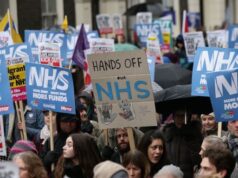‘GP at Hand’ with 51,596 Patients Threatens to Destabilise NHS Services in London
GP at Hand, Babylon Health’s virtual GP practice, has in just 18 months signed up and retained 51,596 patients. However, the ‘GPonline’ web site tells us that between November 2017 and March 2019 one in four of its patients had subsequently left the GP at Hand practice. 85% of those who signed up were aged between 20 and 39, and just over half of them were aged between 20 and 29.
GP at Hand is a Smartphone based app which facilitates online GP consultations at short notice. When you sign up to the virtual service, your registration at your place-based GP practice is cancelled. GP at Hand’s clinics include two in Fulham, a BUPA Health Clinic in Kings Cross, Lyca Health in Canary Wharf (part of the Lyca mobile phone operation), and one, the South Westminster Centre for Health, in Vincent Square. The latter appears to be run by diagnostic imaging specialists InHealth whose Cardiology Unit appears to have a link with Chelsea and Westminster Hospital.
In what the ‘Pulse’ web site describes as ‘destabilising’, it seems GP at Hand is in the process of registering its own NHS Primary Care Network (PCN). The aim of PCNs is collaborative working between GP practices, community, mental health, social care, pharmacy, hospital and voluntary services. Seven such PCNs have just been set up in Ealing. Each PCN can service up to 50,000 registered patients. GP leaders have expressed concerns that this ‘digital-first’ service will break the rule that PCN’s must exist within local boundaries. They predict that if virtual GP practices can become PCNs then it would destabilise all current NHS services in London.
We still await the results of the evaluation of GP at Hand carried out by Ipsos Mori which was first promised in March 2019. Publication of the results has been delayed three times now. NHS England and Hammersmith & Fulham (H&F) CCG commissioned this research which cost £250,000. The results were scheduled to be announced at the H&F CCG meeting on 21 May 2019. The presentation was cancelled at one hour’s notice, the CCG citing concerns about ‘factual accuracy’. Ipsos Mori, a 40 year old global leader in market research operating in 89 countries, is unlikely to be guilty of ‘factual inaccuracy’. However, ‘GPonline’ quotes Ipsos Mori researchers saying that ‘necessary datasets’ have not been made available to them.
Here we have a non-NHS provided service ‘approved’ by NHSE and personally endorsed by the Secretary of State for Health and Social Care. Maybe there are other virtual GP surgery offerings – maybe not. Apparently competitors include ‘Livi’ and ‘Push Doctor’. Have they (and possibly others) been ‘approved’ by NHSE? Perhaps GP at Hand should be nationalised and all GP surgeries mandated to offer it to all their patients. This would create a level playing field. Currently we have a tilted playing field which does not favour place-based GP surgeries in Hammersmith & London and elsewhere who are losing patients to GP at Hand.
GP at Hand appears to have a virtual monopoly in the virtual GP Surgery market. Although it is not illegal in England to set up a monopoly it is illegal to maintain one. Does Matt Hancock MP realise that by his publicly endorsing GP at Hand he is enabling the maintenance of a monopoly?
H&F CCG are facing an annual deficit of £37 million, 21.6 million of which stems from funding the growing patient lists of Fulham-based Dr Jefferies’ GP at Hand practice.
On 2 June 2019 ’The Sunday Times’ revealed worrying data about Babylon Health retrieved from the professional networking service ’LinkedIn’. Although high staff turnover rates are not unusual at tech star-ups, the fact the 37% of Babylon staff stay for 6 months or less is a real concern.
And Now We Have Virtual A&E…..
On 24 May 2019 ‘The Guardian’ exclusively revealed that sick patients in Birmingham will soon be able to seek emergency treatment by using their Smartphone instead of going immediately to a hospital A&E unit. They will engage in a two minute online triage to check their symptoms. This is yet another example of ‘demand management’ at work (see story below). The plan is to persuade 30% of those currently attending a place-based A&E to use a virtual A&E instead.
Not surprisingly Matt Hancock’s favourite ‘digital-first’ technology company Babylon Health is involved. A modified version of GP at Hand will be adopted by the University Hospitals Birmingham NHS Trust. The technology will be used to reduce face-to-face consultations in the areas of outpatients, chronic disease management (diabetes and heart problems) and in triage for Non-Elective hospital admissions.
NHS Says Charging for Nurse Training Will Result in 68,500 Unfilled Nursing Vacancies by 2013/24
The ‘Interim NHS Staff Plan’ has just been leaked and it makes worrying reading. It alleges that following the Government’s decision to abolish training bursaries for nurses, applications for nurse and midwifery training fell by 31% from 2016 to 2018. Clearly these dire predictions about staff shortages must have an impact on implementing the NHS Long Term Plan
The NHS Chief Executive Argues Against Policies He Has Championed
Simon Stevens has recently spoken in public about preventing the ‘hollowing out’ of District General Hospitals (DGHs). This is from the man who had allowed NHS North West London to hollow out Central Middlesex, Hammersmith and Ealing DGHs. The former two had their A&Es closed down in September 2014, and Ealing Hospital has in recent years been stripped of Maternity, Paediatrics, children’s A&E and Urology.
Delivering a lecture at the Royal Society of Medicine (RCM) in May 2019, Mr Stevens suggested that the NHS rethinks the DGH model to counter the risk of the health service deserting the ‘at risk communities’ many of them serve. This is all a bit rich when one considers that the hollowed-out Ealing Hospital is located in Southall, one of the most deprived areas in England.
Is what he is saying that he got it wrong in the past and he’ll put it right in the years to come? Well there’s nothing on in the ten year ‘NHS long Term Plan’ (LTP) published in January 2019 about reversing the hollowing out of DGHs.
So….how do we resolve these conflicting NHSE statements in the LTP and in the RCM lecture?
Is the Incidence of ‘Demand Management’ Initiatives a Potent Symbol of Neo-Liberal Dogma Permeating the NHS?
The concept of ‘demand management’ has a lot to do with ‘market’ situations when supply is dwindling – by design, by incompetence or by accident. Demand management initiatives somehow attempt to divert, bamboozle or even ‘educate’ the demander, resulting in their demands not being met or supply being delayed. If chocolate bars become in short supply demand management could raise prices or it could point out that too much chocolate is bad for you and offer the demander fruit (in greater supply) instead.
In the NHS since at least 2010, reducing the number of District General Hospitals (DGHs) and the number of hospital beds has been a design mandate. Hospitals are expensive places to run and NHS bosses started downgrading DGHs and reducing bed numbers as a way to cut costs. In NHS North West London (NWL) in 2012 bosses accepted the wisdom of management consultants McKinsey & Co that 40% of patients in Acute beds should not be there. Reducing bed numbers by 40% was the plan, but this plan was finally abandoned in March 2019. However in the 28 May 2019 NHS NWL commissioning reform paper, we are told that 30% of patients in Acute beds should not be there.
Whether by design, incompetence or accident, the number of doctors and nurses at work in the NHS is inadequate. In April 2019 NHS Improvement announced there were 100,521 NHS staff vacancies in England.
Various demand management techniques have been tried to reduce the number of people attending and being admitted to hospital. These include:
+ efforts to treat patients at home or in doctors’ surgeries (instead of in hospital)
+ attempts to make people lead healthier lives
+ initiatives to detect and treat potentially serious illnesses in their early stages which reduces the need for patients to enter intensive care in hospital
+ telephone voice and Smartphone online triage and treatment – hoping this will deter patients from turning up at GP surgeries, hospital Urgent Care Centres and hospital A&E departments.
+ ‘referral facilitation’ – slowing down, changing, or rejecting GP patient referrals to see hospital consultants
Some of these techniques have proved successful and some have failed.
If you want to see your usual GP it’s not unusual these days to have to wait three weeks for the privilege. Two requests in recent years for over £70 million to expand some GP surgeries in North West London have fallen on deaf ears at NHS England and the Department of Health.
Government smoking bans have been successful in reducing self-harm through nicotine/tar ingestion. However campaigns aimed at reducing self-harm from many other forms of substance abuse have had little success.
Initiatives with the elderly in detecting early stage bowel cancer, encouraging them to have flu jabs and self-checking their blood pressure at home have no doubt enjoyed some success. However there have been few publicised successful initiatives in detecting and treating early onset mental illnesses in children of all ages.
The jury is still out as to whether virtual GP surgeries, e.g. GP at Hand, are safe and effective and whether they might prove to be a universal panacea in Primary, Community and Secondary Care demand management.
In Ealing a referral facilitation service has been operating for a few years. A second GP reviews your GP’s referral for you to see a consultant. Well, it’s just been decided to discontinue this service in Ealing as allegedly it was proving to be a waste of money.
In the current NHS Long Perm Plan (LTP) the new Primary Care Networks (PCNs) will be financially rewarded if there are reductions in Acute hospital admissions amongst their 30,000 to 50,000 registered patient populations.
Also in the LTP, PCNs are expected to form multi-discipline teams to visit and treat patients at home in attempts to reduce the number of patients attending and being admitted to DGHs. This multi-discipline team approach has been tried throughout NHS North West London in recent years. Anecdotally I hear that it has been largely abandoned as it proved difficult to organise.
Reducing ‘bed blocking’ has gained much press attention in recent years. But has much been achieved in reducing it? At Ealing Hospital bed blocking, often by mentally ill and elderly patients, has effectively reduced the available beds even more. Because the number of specialist mental health beds have been reduced it’s often very difficult to discharge seriously ill mental patients. Government cuts to Local Authority funding have often resulted in much reduced care home capacity and home care services, sometimes making it impossible for recovering elderly patients to be safely discharged from hospital.




